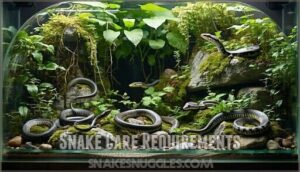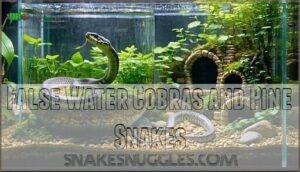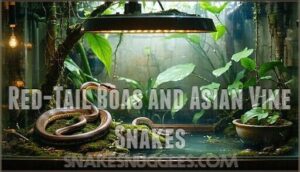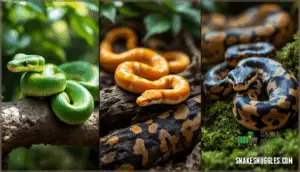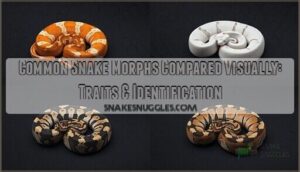This site is supported by our readers. We may earn a commission, at no cost to you, if you purchase through links.
 When you’re ready to add a scaly companion to your family, a thorough pet snake species list becomes your roadmap to finding the perfect match.
When you’re ready to add a scaly companion to your family, a thorough pet snake species list becomes your roadmap to finding the perfect match.
Beginner-friendly options like corn snakes and ball pythons offer forgiving care requirements and docile temperaments, while species such as kingsnakes and milk snakes provide colorful variety without demanding expertise.
Advanced keepers often gravitate toward boas, pythons, or specialized species that require precise environmental controls.
Each species brings unique personality traits, size considerations, and lifespan commitments—corn snakes might live 15+ years, while some pythons can become decades-long companions.
The secret lies in understanding which species align with your experience level, available space, and local regulations before making this long-term commitment.
Table Of Contents
- Key Takeaways
- Snake Care Requirements
- Advanced Pet Snake Species
- Choosing The Right Snake
- Snake Habitat and Equipment
- Frequently Asked Questions (FAQs)
- What is the best species of snake to have as a pet?
- What snakes can you own as a pet?
- What is the most cuddly pet snake?
- What is the least aggressive pet snake?
- What snake species live the longest?
- Which snakes require the least space?
- Are there venomous beginner pet snakes?
- Whats the most affordable snake species?
- Which snakes are easiest to breed?
- Conclusion
Key Takeaways
- Match your experience level to the snake species—beginners should stick with corn snakes and ball pythons, while advanced keepers can handle boas and specialized species that need precise environmental controls.
- Research local laws thoroughly before purchasing, as many states and cities restrict or ban certain snake species, and some require expensive permits or documentation.
- Prepare for a long-term commitment since most pet snakes live 15-30+ years, with some species requiring decades of consistent care, proper feeding schedules, and appropriate housing upgrades as they grow.
- Create proper habitat conditions with temperature gradients of 85-95°F basking spots, 40-75% humidity levels, and species-appropriate substrate—these environmental factors directly impact your snake’s health and lifespan.
Snake Care Requirements
Understanding your snake’s basic care requirements guarantees a healthy, thriving pet that’ll live for years to come.
You’ll need to master three key areas: proper temperature and humidity control, consistent feeding schedules, and suitable housing setups.
Temperature and Humidity Needs
Maintaining proper thermal gradients and humidity levels is essential for your snake’s health.
You’ll need basking temperatures of 85-95°F with ambient temperatures 10-15°F cooler. Heat sources like ceramic heaters create these gradients effectively.
Most species require 40-75% humidity, monitored with reliable hygrometers.
Temperature regulation prevents illness, while proper humidity supports healthy shedding cycles.
Understanding temperature controls is essential for a healthy pet snake.
Feeding and Watering Requirements
Your snake’s dietary needs are straightforward but require consistency.
Most pet snakes eat frozen-thawed mice or rats based on their size, with juveniles eating weekly and adults every 10-14 days.
Fresh water should always be available in a heavy bowl that won’t tip over.
Food types vary by species, but pre-killed prey is safest and most convenient for snake feeding and proper snake hydration.
Enclosure and Substrate Options
Your snake’s home needs proper planning. Choose terrarium sizes based on adult length—a 40-gallon tank works for most medium species.
Substrate types like aspen shavings, cypress mulch, or paper towels each offer benefits. Aspen allows burrowing, while paper simplifies cleaning.
Enclosure materials should provide secure ventilation systems and include snake hides on both warm and cool sides for comfort. Understanding the importance of substrate selection basics is essential for maintaining a healthy environment for your pet snake, which requires complete concepts of snake care.
Advanced Pet Snake Species
Once you’ve mastered beginner species, advanced snakes like False Water Cobras and Red-Tail Boas offer exciting challenges with their larger sizes and specific care requirements.
These species demand more experience but reward dedicated keepers with impressive displays and unique behaviors that make the extra effort worthwhile, especially for those interested in advanced snakes.
False Water Cobras and Pine Snakes
False water cobras and pine snakes represent advanced pet snake species requiring specialized care.
These cobra behavior experts need spacious enclosures—water cobras demand 5-foot minimum lengths for semi-aquatic activities, while pine snakes require 4x2x2 feet for burrowing.
Water cobra habitat includes large swimming bowls, whereas pine snake morphs thrive with deep, loose substrates.
Both species showcase unique temperaments through confident handling approaches. To guarantee proper care, it’s vital to research their semi aquatic lifestyle and create an environment that meets their specific needs, ensuring a suitable environment.
Red-Tail Boas and Asian Vine Snakes
Keeping these magnificent giants requires serious commitment.
Red-tail boas need spacious enclosures reaching 8-10 feet, while Asian vine snakes demand precise humidity levels for proper shedding.
Both species challenge experienced keepers with specific boa constrictor care requirements.
Your redtail boa’s feeding schedule differs drastically from delicate vine species needs.
Consider snake handling experience before choosing these advanced pet snake species.
Understanding the red tail boa characteristics is vital for providing the best care and environment, which is a key part of proper shedding.
Choosing The Right Snake
Selecting the right snake species requires matching your experience level with the animal’s care requirements and adult size.
You’ll also need to research local laws, as some municipalities restrict or ban certain species, while considering factors like lifespan commitment and handling temperament.
Consideration of Longevity and Size
Size matters when choosing your forever friend. Ball python owners commit to 20-30 years with a compact 3-5 foot companion, while king snake enthusiasts face similar snake longevity with larger 6-7 foot adults.
Consider your living space and future plans—pet snake species grow substantially from hatchlings. Animal care responsibilities intensify with larger snakes requiring bigger enclosures, more food, and stronger handling considerations throughout their species lifespan.
Understanding snake temperaments is vital for making an informed decision about the right pet snake, considering factors like living space and animal care to ensure a compatible and happy relationship with your pet snake.
Location and Laws Regarding Pet Snakes
Your area’s pet laws can make or break your snake-owning dreams. Research regulations before falling for that gorgeous ball python at the expo.
- State restrictions – Hawaii bans all snakes; Florida prohibits large constrictors
- Local ordinances – Cities may impose stricter rules than state laws
- Permit requirements – Exotic species often need annual licenses ($20-50)
- Import restrictions – International transfers require CITES documentation
Handling and Temperament Considerations
Choosing the right snake means understanding snake temperament and how different species respond to snake handling.
Docile species like corn snakes rarely show defensiveness, while others may be nippy.
| Temperament Types | Snake Behavior | Handling Techniques |
|---|---|---|
| Docile snakes | Calm, rarely bite | Support body, move slowly |
| Defensive species | May hiss or strike | Use snake hook initially |
| Nippy varieties | Quick to bite | Wear gloves, stay confident |
Snake Habitat and Equipment
You’ll need the right equipment to create a safe and comfortable home for your snake.
Setting up proper heating, lighting, and substrate in an appropriate enclosure guarantees your pet thrives and stays healthy throughout its life.
Terrarium and Enclosure Options
Your snake’s new home requires careful planning to guarantee comfort and security.
Success starts with creating the perfect environment for your snake’s long-term happiness.
Glass aquariums work well for most species, while plastic tubs offer excellent heat retention for humidity-loving pythons.
When setting up a snake terrarium, consider the importance of proper snake terrarium equipment for a healthy environment.
- Terrarium Designs: Choose front-opening enclosures for easier access and reduced stress
- Enclosure Materials: Glass provides visibility, while PVC retains heat and humidity better
- Snake Hides: Provide identical hides on warm and cool sides for thermoregulation
- Ventilation Systems: Guarantee proper airflow without creating drafts that cool your snake
Heating and Lighting Requirements
Proper temperature control transforms your snake’s enclosure into a thriving habitat. You’ll need heat lamps or ceramic heaters to create basking spots at 85-95°F, while ambient heating maintains cooler areas around 75-80°F.
UV lighting isn’t essential but supports natural behaviors and vitamin D production in many species.
| Heat Source | Temperature Range | Best For |
|---|---|---|
| Under-tank heaters | 80-90°F | Ambient heating, nighttime warmth |
| Ceramic heat emitters | 85-95°F | Basking spots, 24-hour heating |
| Heat lamps | 85-100°F | Daytime basking, visual heat source |
| UV lighting | N/A (behavioral) | Corn snakes, colubrids, pythons |
| Infrared bulbs | 80-95°F | Night heating without light |
Always use thermostats with every heating element to prevent dangerous temperature spikes that could harm your snake. Understanding proper snake heating is vital for creating a suitable environment for your pet.
Bedding and Substrate Choices
Beyond proper heating, your snake’s substrate choice impacts both comfort and health.
Select bedding that absorbs moisture while preventing bacterial growth in your snake enclosure.
Consider these popular snake substrate options:
- Aspen Substrate – Excellent for burrowing species, easy snake enclosure cleaning
- Coconut Fiber – Retains humidity well, reduces snake enclosure substrate irritation
- Sphagnum Moss – Perfect for humid hides, natural appearance
- Reptile Carpet – Reusable option, though Sand Bedding isn’t recommended
Using the right aspen substrate products is essential for a healthy environment.
Add snake enclosure branches for climbing species.
Frequently Asked Questions (FAQs)
What is the best species of snake to have as a pet?
You’ll find corn snakes (Pantherophis guttatus) are your best bet – they’re docile, hardy, and come in over 700 stunning color morphs, making them perfect starter serpents.
What snakes can you own as a pet?
You can keep numerous snake species as pets, from beginner-friendly corn snakes and ball pythons to advanced options like reticulated pythons and boas.
What is the most cuddly pet snake?
Picture Sarah, a first-time snake owner, gently holding her ball python as it wraps around her arm—that’s about as "cuddly" as snakes get.
You’ll find ball pythons most tolerant of handling, staying calm when held properly, though they don’t actually seek affection like mammals do.
What is the least aggressive pet snake?
Corn snakes and ball pythons top the docile list. You’ll find these gentle giants rarely bite, making them perfect starter snakes for nervous handlers seeking calm companions.
What snake species live the longest?
Ball pythons reign as longevity champions, living 30+ years like wise old trees weathering decades.
You’ll find rosy boas equally impressive, reaching 30+ years with proper care.
Red-tail boas also exceed 30 years, making them lifetime companions for dedicated keepers.
Which snakes require the least space?
Kenyan sand boas need minimal space, growing only 5-2 feet.
You’ll also find garter snakes (2-3 feet) and hognose snakes (under 3 feet) work well in smaller terrariums compared to larger species.
Are there venomous beginner pet snakes?
Avoid venomous snakes entirely—they’re dangerous, illegal in most areas, and require specialized permits.
You’ll find plenty of non-venomous beginner species like corn snakes that offer safe, rewarding experiences without risking your freedom or safety.
Whats the most affordable snake species?
Garter snakes offer you the best bang for your buck, typically costing $20-50 compared to ball pythons at $50-
They’re hardy, easy to care for, and won’t break the bank on startup costs either.
Which snakes are easiest to breed?
Corn snakes and kingsnakes top the list for beginners seeking to breed snakes.
They’re hardy, prolific layers with straightforward care requirements and predictable breeding cycles that make reproduction relatively foolproof.
You’ll find they have these characteristics, making them ideal for beginners.
Conclusion
Selecting from countless options versus choosing the perfect match—this extensive pet snake species list bridges that gap by matching your experience with suitable companions.
Whether you’re drawn to beginner-friendly corn snakes or challenging red-tail boas, success depends on honest assessment of your capabilities and commitment.
Each species demands specific care requirements, from temperature gradients to feeding schedules, and proper research prevents costly mistakes.
You’ll discover that this research guarantees both you and your scaly friend thrive for years ahead, and that each species has unique needs that must be met to ensure a healthy and happy relationship, which is key to long-term success.
- https://www.chewy.com/education/reptile-and-amphibian/snake/best-pet-snakes
- https://www.tampavet.com/exotics-blog/best-beginner-snakes/
- https://reptilesmagazine.com/5-great-beginner-pet-snakes/
- https://www.reddit.com/r/snakes/comments/txyzvv/best_pet_snake_for_a_beginner/
- https://www.ingleside.com/services/other-pets/blog/top-5-beginner-friendly-pet-snakes-according-vets

